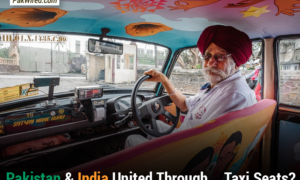When was the last time you got into a taxi and actually paid attention to what the seats looked like? Moreover, when was the last time you paid attention and actually liked what you saw?
An innovative project entitled Taxi Fabric wants to change the way we see taxi seats, particularly in Mumbai, by using them as canvases for designers around the world.
“It’s a blind spot, isn’t it? Taxi seat covers, I mean,” says the founder of Taxi Fabric Sanket Avlani. “When I was working in Mumbai, taxis were my primary mode of transport and it’s really a misconception that these drivers don’t care what their vehicles look like. Like occasionally, they revamp the taxis from outside by putting on stickers and stuff like that but it dawned on me that no one was paying attention to the interior.”
However, Avlani’s journey has not been particularly smooth. “The idea developed as I brainstormed what to do to make the seat covers more enticing with a few artistic friends,” he recalls. “When we went into production initially, we got a bit of a reality check.
“To have an idea in your head and to execute it are two very vastly different things. From there started our long journey into making Taxi Fabric a practical reality — we spoke to a lot of taxi drivers, examined the taxis. It took us a couple of years to solidify our purpose but here we are now, on our tenth taxi.”
Taxi Fabric is aiming to decorate around fifty taxis within the next year, having raised $17,000 on Kickstarter. Meanwhile, one of the taxis they have already renovated is receiving significant praise, particularly from the Pakistani community.
Taxi Fabric collaborated with graphic designer Samya Arif of Karachi to decorate the back of a taxi with a piece entitled ‘Monad’ in celebration Pakistan’s Independence Day. The main focus of the piece was the numerous similarities between Pakistan and India, despite the conflict between the two nations.
Regarding her design, Arif says: “I have picked up on hand gestures and geometric patterns common or unique to both cultures and religions such as a dua or namaste and amalgamated them into a visual collage around a sea scape.”
Having approached Arif after viewing her work online, Avlani could not be more pleased. “Samya’s been such a trooper about the whole process,” he says. “Obviously, she couldn’t be there in person so it was a little tougher, we paid great attention to detail because we wanted to do her work justice.”
Regarding the process, Avlani explains: “we pick an illustrator; that is obviously the first step. We don’t just focus on upcoming designers but established ones who can preferably fund their own taxi fabric are also welcomed onboard. Once that has been filtered, we talk to the artist, give them a demo of a taxi that’s been done before, if possible. We also really encourage that they meet and talk to the drivers.
“The production and fabric fitting process is lengthy. The cab and every panel in it has to be measured precisely so that the fabric is cut and stitched on properly. Us designers, we’re fussy people so often, the smallest detail being neglected means the fabric has to be reprinted but I don’t mind; their hard work deserves the time.”
Avlani, who currently lives in the United Kingdom, is unsure as to how their hardwork will be maintained but is hoping to take Taxi Fabric even further.
“To see a person’s mastery of craft displayed on a public medium is something that inspires me beyond bounds,” he says, “When you see people interact with your work and give feedback, it evokes a different spark altogether so this [Taxi Fabric] is something that really excites me.”
When asked which of the taxi seats was his favourite, Avlani laughed. “I couldn’t possibly pick one they all have their own story and significance. However, I can tell you which one is my least favourite: the one I designed!”
“All in all, we’re really happy with the way everything turned out,” says Avlani. “It’s an experience that has changed me completely; we’re conditioned to believe things that are untrue but when a Pakistani and an Indian interact like this, you realize how similar we really are.”
Featured image via: Taxifabric.


